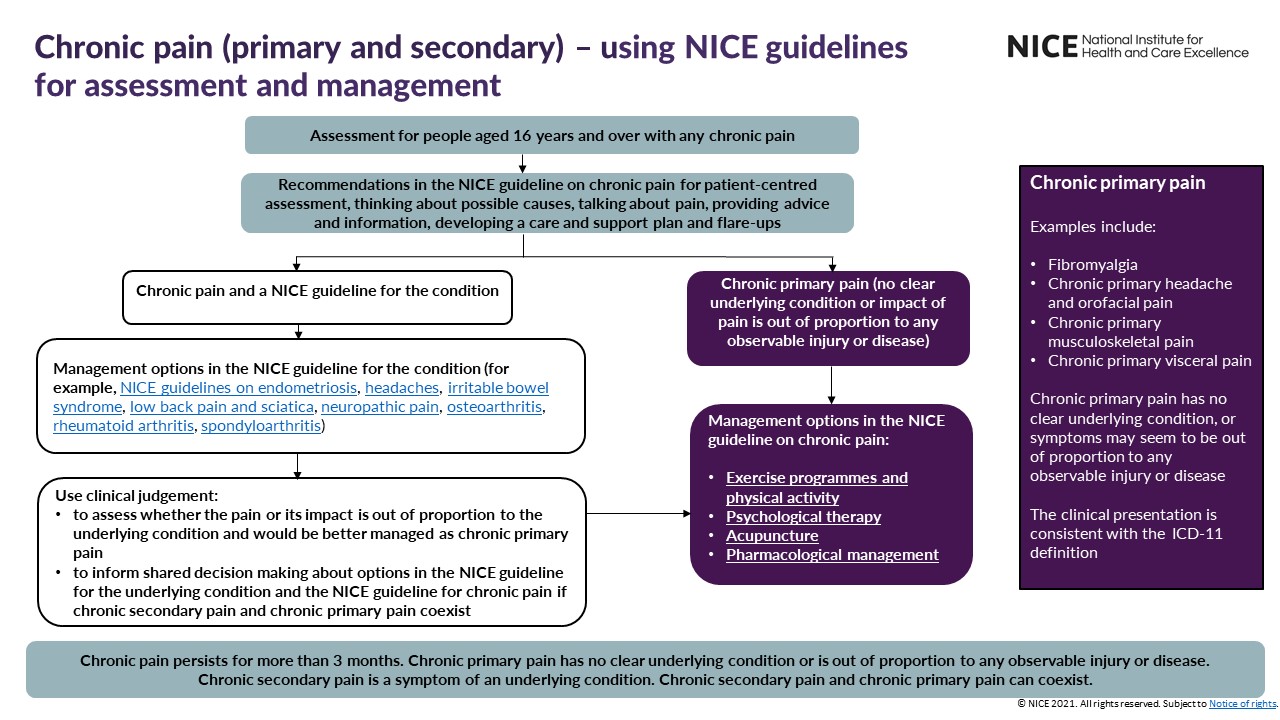Overview
This guideline covers assessing all chronic pain (chronic primary pain, chronic secondary pain, or both) and managing chronic primary pain in people aged 16 years and over. Chronic primary pain is pain with no clear underlying cause, or pain (or its impact) that is out of proportion to any observable injury or disease.
This guideline should be used alongside NICE guidelines for other chronic pain conditions, including the NICE guidelines on headaches, low back pain and sciatica, rheumatoid arthritis, osteoarthritis, spondyloarthritis, endometriosis, neuropathic pain and irritable bowel syndrome.
The recommendations in this guideline were developed before the COVID-19 pandemic.
Recommendations
This guideline includes recommendations on:
- assessing all types of chronic pain (chronic primary pain, chronic secondary pain, or both) and developing a care and support plan
- managing chronic primary pain
Who is it for?
- Healthcare professionals
- Commissioners and providers of services
- People with chronic primary pain and chronic secondary pain, their families and carers
Guideline development process
How we develop NICE guidelines
This guideline was commissioned by NICE and developed in partnership with the Royal College of Physicians (RCP).
This guideline updates and replaces evidence summary ESUOM27.
Your responsibility
The recommendations in this guideline represent the view of NICE, arrived at after careful consideration of the evidence available. When exercising their judgement, professionals and practitioners are expected to take this guideline fully into account, alongside the individual needs, preferences and values of their patients or the people using their service. It is not mandatory to apply the recommendations, and the guideline does not override the responsibility to make decisions appropriate to the circumstances of the individual, in consultation with them and their families and carers or guardian.
All problems (adverse events) related to a medicine or medical device used for treatment or in a procedure should be reported to the Medicines and Healthcare products Regulatory Agency using the Yellow Card Scheme.
Local commissioners and providers of healthcare have a responsibility to enable the guideline to be applied when individual professionals and people using services wish to use it. They should do so in the context of local and national priorities for funding and developing services, and in light of their duties to have due regard to the need to eliminate unlawful discrimination, to advance equality of opportunity and to reduce health inequalities. Nothing in this guideline should be interpreted in a way that would be inconsistent with complying with those duties.
Commissioners and providers have a responsibility to promote an environmentally sustainable health and care system and should assess and reduce the environmental impact of implementing NICE recommendations wherever possible.
